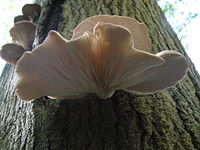
Photo from wikipedia
Synthetic dye bioremediation is a topic of great importance since these pollutants possess toxic effects, and huge quantities of them are being discharged into water bodies. Ligninolytic enzyme treatment stands… Click to show full abstract
Synthetic dye bioremediation is a topic of great importance since these pollutants possess toxic effects, and huge quantities of them are being discharged into water bodies. Ligninolytic enzyme treatment stands out for being a cost-effective methodology, capable of obtaining high decolorization levels. In this work, a laccase enzyme treatment was evaluated to effectively perform a cycle of dye bioremediation. Furthermore, a dye decolorization improvement was also assessed through laccase immobilization. Particularly, a Trametes pubescens enzyme extract was concentrated, immobilized onto calcium alginate beads, and characterized to assess its dye decolorization potential. Ammonium sulfate precipitation and vacuum evaporation were evaluated to concentrate the crude extract and to decolorize allura red AC. Both treatments reached a high enzyme yield recovery (>90%), but only the vacuum-evaporated extract achieved a high allura red AC decolorization level after 16 h of contact time. This suggested that essential compounds for allura red AC decolorization were present in the crude extract, implying that neither a complete laccase purification process nor an addition of synthetic mediators are necessary. Under optimized immobilization conditions, 94.6% immobilization efficiency and 49.8% activity recovery were obtained with 0:1 alginate:enzyme (v/v), 100 mM CaCl2, and 5.0% w/v sodium alginate. Furthermore, by immobilizing the laccase concentrated extract, both the pH and temperature stabilities were improved. The decolorization of allura red AC by free and immobilized laccase was 68.4% and 4.6%, respectively, showing that although the enzyme stability was improved, dye decolorization was negatively affected. Thus, an efficient allura red AC decolorization was obtained with concentrated-free laccase by a feasible and low-cost methodology.
Journal Title: Journal of environmental management
Year Published: 2021
Link to full text (if available)
Share on Social Media: Sign Up to like & get
recommendations!